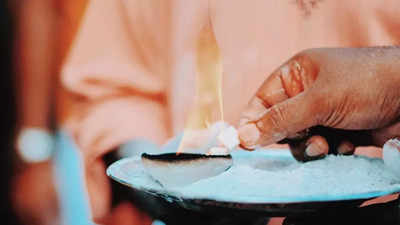
In temples and homes in India, the air is filled with the scent of camphor, and sacred flames are waved in the presence of the gods during aarti. This ancient ritual performed with devotion and reverence is more than just a ritual tradition, it has deep spiritual significance and has evolved over centuries in Hindu worship.
What is camphor and why is it used in aarti?
Camphor, aka. Kapoor In Hindi, a crystalline substance extracted from the bark and wood of the camphor tree (cinnamon and camphor). Known for its purity and unique aroma, camphor is used in various Hindu rituals, especially during the aarti ceremony, where camphor is burned to create a small, fragrant flame that is believed to have deep spiritual significance.
The symbolic meaning of camphor in Hindu worship
The use of camphor in aarti has symbolic meanings rooted in Hindu philosophy:
- Selflessness and purity: Camphor is said to symbolize the human ego. When it is lit during aarti, it burns completely without leaving any residue, which means that one’s ego dissolves in the presence of the Divine. Believers are reminded to renounce their personal identity and dedicate themselves completely to God.
- Guide the inner light: The flame of camphor illuminates the face of God, symbolizing the presence of divine light in the life of the devotee. In Hindu philosophy, fire is considered a purifier, and the aarti flame represents burning away impurities, helping the worshiper connect with the inner self and the divine.
- protection and positivity: The aroma of camphor is believed to have protective properties, ward off negative energy and bring about a feeling of calm and purity. Therefore, the aarti ritual becomes not only an act of worship but also an act of spiritual purification.
- Links to ancient traditions: Camphor’s importance in worship is not recent; its history goes back centuries. The act of burning camphor in rituals is believed to have originated during the Vedic period, when natural elements such as fire, water and air were believed to be mediums to reach the gods.
The process and respect of aarti
Aarti usually marks the end of worship rituals. Place a small piece of camphor in a metal stand or plate and light it in front of the idol. The flame then waves in a circular motion (usually clockwise), symbolizing the universe’s cycle of birth, life and death. Believers gather the warmth of the flame with their hands and touch it to their eyes or forehead to symbolize receiving divine blessings.
In addition to its symbolic value, camphor’s antiseptic properties make it practical in temple settings. Its smoke is believed to purify the air, reinforcing the concept of aarti to purify the physical and spiritual atmosphere.
Camphor’s influence extends beyond temples
Today, the role of camphor in aarti has expanded from temples to homes and personal shrines, where families use it to create a sense of sanctity. This practice resonates with the message of selflessness, purity and humility, encouraging devotees to approach life with a spirit of surrender to God.
Tradition passed down from generation to generation
this The meaning of camphor The word “aarti” has been passed down from generation to generation and has become an integral part of Indian spiritual culture. Whether in a grand temple ceremony or a simple family ritual, the act of burning camphor triggers a sense of oneness with the divine, encouraging believers to seek enlightenment and inner peace.
As devotees witness the symbolic transformation of camphor from solid to flame, they are reminded of their own spiritual journey—a devotion to the divine, illuminated by the light of devotion and compassion.
!(function(f, b, e, v, n, t, s) { function loadFBEvents(isFBCampaignActive) { if (!isFBCampaignActive) { return; } (function(f, b, e, v, n, t, s) { if (f.fbq) return; n = f.fbq = function() { n.callMethod ? n.callMethod(...arguments) : n.queue.push(arguments); }; if (!f._fbq) f._fbq = n; n.push = n; n.loaded = !0; n.version = '2.0'; n.queue = (); t = b.createElement(e); t.async = !0; t.defer = !0; t.src = v; s = b.getElementsByTagName(e)(0); s.parentNode.insertBefore(t, s); })(f, b, e, 'https://connect.facebook.net/en_US/fbevents.js', n, t, s); fbq('init', '593671331875494'); fbq('track', 'PageView'); };
function loadGtagEvents(isGoogleCampaignActive) { if (!isGoogleCampaignActive) { return; } var id = document.getElementById('toi-plus-google-campaign'); if (id) { return; } (function(f, b, e, v, n, t, s) { t = b.createElement(e); t.async = !0; t.defer = !0; t.src = v; t.id = 'toi-plus-google-campaign'; s = b.getElementsByTagName(e)(0); s.parentNode.insertBefore(t, s); })(f, b, e, 'https://www.googletagmanager.com/gtag/js?id=AW-877820074', n, t, s); };
function loadSurvicateJs(allowedSurvicateSections = ()){ const section = window.location.pathname.split('/')(1) const isHomePageAllowed = window.location.pathname === '/' && allowedSurvicateSections.includes('homepage')
if(allowedSurvicateSections.includes(section) || isHomePageAllowed){ (function(w) {
function setAttributes() { var prime_user_status = window.isPrime ? 'paid' : 'free' ; w._sva.setVisitorTraits({ toi_user_subscription_status : prime_user_status }); }
if (w._sva && w._sva.setVisitorTraits) { setAttributes(); } else { w.addEventListener("SurvicateReady", setAttributes); }
var s = document.createElement('script'); s.src="https://survey.survicate.com/workspaces/0be6ae9845d14a7c8ff08a7a00bd9b21/web_surveys.js"; s.async = true; var e = document.getElementsByTagName('script')(0); e.parentNode.insertBefore(s, e); })(window); }
}
window.TimesApps = window.TimesApps || {}; var TimesApps = window.TimesApps; TimesApps.toiPlusEvents = function(config) { var isConfigAvailable = "toiplus_site_settings" in f && "isFBCampaignActive" in f.toiplus_site_settings && "isGoogleCampaignActive" in f.toiplus_site_settings; var isPrimeUser = window.isPrime; var isPrimeUserLayout = window.isPrimeUserLayout; if (isConfigAvailable && !isPrimeUser) { loadGtagEvents(f.toiplus_site_settings.isGoogleCampaignActive); loadFBEvents(f.toiplus_site_settings.isFBCampaignActive); loadSurvicateJs(f.toiplus_site_settings.allowedSurvicateSections); } else { var JarvisUrl="https://jarvis.indiatimes.com/v1/feeds/toi_plus/site_settings/643526e21443833f0c454615?db_env=published"; window.getFromClient(JarvisUrl, function(config){ if (config) { const allowedSectionSuricate = (isPrimeUserLayout) ? config?.allowedSurvicatePrimeSections : config?.allowedSurvicateSections loadGtagEvents(config?.isGoogleCampaignActive); loadFBEvents(config?.isFBCampaignActive); loadSurvicateJs(allowedSectionSuricate); } }) } }; })( window, document, 'script', );







